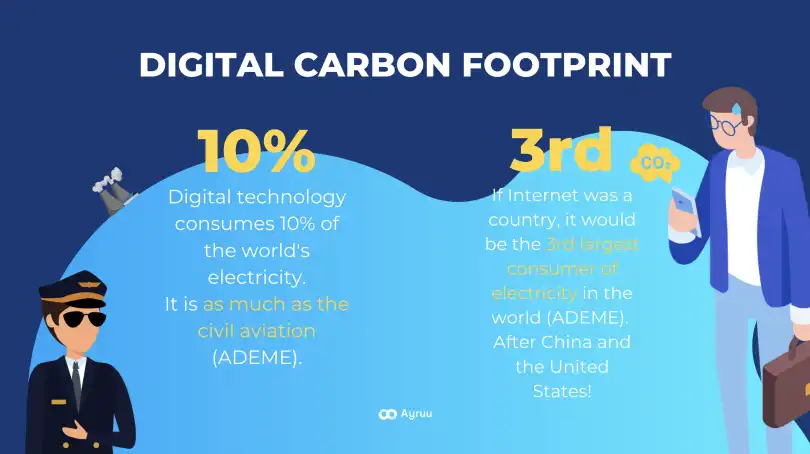Our tool for an easy IT fleet carbon assessment
It is now established that the digital sector contributes to 2.5% of global greenhouse gas emissions each year, largely due to energy-intensive IT equipment. A study by ADEME, entitled "Conso IT" and conducted among 50 companies of various sizes in Western France, revealed that the IT equipment of these companies alone generated a carbon footprint equivalent to that of 10,000 homes. How can companies improve the environmental footprint of their equipment? The first step is to assess the GHG footprint of their IT assets!
Our teams have developed a calculator dedicated to the IT GHG emissions assessment in order to help our customers estimate the carbon impact of their IT assets. When it comes to calculating carbon emissions , multiple uncertainties come into play. However, even with its imperfections, this assessment has its advantages. The GHG assessment of IT assets allows to :
- Identify the main sources of emissions: Thanks to this tool, it becomes possible to determine the main causes of carbon emissions related to digital equipment.
- Identify and prioritize areas for improvement: Once the sources have been identified, it becomes easier to prioritize actions to reduce the environmental impact of equipment.
- Comparing emissions from one year to the next: It is essential to establish starting hypotheses and define the scope of the study in order to be able to keep them when drawing up subsequent assessments. This allows relevant comparisons to be made.
This audit, the results of which will be clearly presented using our tool, provides a solid basis for a more enlightened management of the environmental impact of the IT assets.

The GHG assessment of digital equipment in a few steps
Our calculator deployed for the GHG assessment of IT assets can be applied to very different typologies of companies, ranging from the banking sector to local authorities. In other words, it is designed to be very adaptable. An IT GHG assessment such as the one we carry out takes place in several stages:
1. Defining the scope
This step is an essential element in establishing a balance sheet. Indeed, the conclusions of a balance sheet can differ considerably depending on the perimeter that is chosen.
The scope of the balance sheets that we draw up varies according to the specificities of each company. Some assessments cover the entire IT infrastructure of a company, while others focus on a specific department or a particular team. It is crucial to choose the most appropriate scope depending on the objectives, the availability of data and the scope of the actions to be taken.
2. Data Collection
Collecting the data required to assess the carbon footprint of an IT asset can be tedious. That's why we've developed a tool that can be used by both accounts with detailed equipment tracking and precise knowledge of their characteristics, as well as those with more basic data on their IT assets.
3. Carbon footprint assessment
Our assessment methodology is based on the segmentation of emissions defined by the GHG Protocol, which sets globally accepted standards for calculation and reporting. This segmentation is also the basis for the ISO 14064 standard. In France, the Bilan Carbone method, developed by ADEME, is also based on this same segmentation.
Using this approach, the IT carbon footprint we establish offers several interesting perspectives. In particular, it allows us to determine in which "scope" most of the emissions are located, but also to identify the equipment with the greatest impact in terms of greenhouse gas emissions.
This segmentation allows for a more in-depth and accurate analysis of emissions, giving companies a clear view of where they can focus their reduction efforts.
4. Identifying avenues for improvement and projections
Based on the conclusions of the assessment, it becomes possible to identify areas for improvement. For example, if some equipment stands out from the others in terms of carbon footprint, it is important to take a closer look: is it due to their number? Is it due to their lifespan? Concrete and personalized recommendations are provided in order to optimize the impact of the computer park.
Using the calculator, it will be possible to make projections on potential gains. During the environmental footprint audit, it is often necessary to complement the results obtained with a contextualized analysis in order to determine whether they are satisfactory and how they compare with those of other organizations.
In order to meet this need for comparison, we have set up a reference scale ranging from A to E.
To assign this rating, the total greenhouse gas emissions of the IT GHG report are compared to a total per employee. This measure, which is independent of the size of the organization, makes it possible to establish relevant comparisons, to share the balance sheet in the interests of transparency and to be part of a continuous improvement process.

A continuous improvement approach to its IT footprint
Even within our company, which is committed to Digital Sustainability, the results are far from impeccable! The IT GHG assessments carried out to date have resulted in an average footprint of 199 kgCO2 per employee. Some have received D and B grades; others, who are good students, have received an A grade. These results are above all a starting point for improving the balance sheet.
The areas for improvement identified to date and recommended by ADEME focus mainly on extending the life of equipment. Indeed, in the life cycle of an appliance, it is the manufacturing stage (which falls under scope 3) that has the greatest impact! To reduce it, here are some concrete actions that can be taken:
- Implementation of a responsible digital purchasing policy
- Reduce the number of digital equipments
- Choice of second home, reconditioned (or failing that, ecolabelled) equipment when purchasing new computer equipment
- Repair damaged equipment instead of replacing it
- Recycle obsolete equipment (WEEE), in particular via eco-organizations.
- Optimize the management of the computer park to reduce its energy expenditure
- Etc.
There are many ways to turn to frugality and digital sobriety today. A GHG assessment of your IT assets is an essential first step to take in order to turn to these best practices, to see what needs to be prioritized within your organization.
